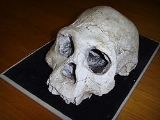
Homo georgicus
Overview
Homo georgicus is a species of Homo
that was suggested in 2002 to describe fossil skulls and jaws found in Dmanisi
, Georgia
in 1999 and 2001, which seem intermediate between Homo habilis
and H. erectus
. A partial skeleton was discovered in 2001. The fossils are about 1.8 million years old. The remains were first discovered in 1991 by Georgian scientist, David Lordkipanidze
, accompanied by an international team which unearthed the remains.
Homo
Homo may refer to:*the Greek prefix ὅμο-, meaning "the same"*the Latin for man, human being*Homo, the taxonomical genus including modern humans...
that was suggested in 2002 to describe fossil skulls and jaws found in Dmanisi
Dmanisi
Dmanisi is a townlet and archaeological site in Kvemo Kartli region of Georgia approximately 93 km southwest of the nation’s capital Tbilisi in the river valley of Mashavera.- History :...
, Georgia
Georgia (country)
Georgia is a sovereign state in the Caucasus region of Eurasia. Located at the crossroads of Western Asia and Eastern Europe, it is bounded to the west by the Black Sea, to the north by Russia, to the southwest by Turkey, to the south by Armenia, and to the southeast by Azerbaijan. The capital of...
in 1999 and 2001, which seem intermediate between Homo habilis
Homo habilis
Homo habilis is a species of the genus Homo, which lived from approximately at the beginning of the Pleistocene period. The discovery and description of this species is credited to both Mary and Louis Leakey, who found fossils in Tanzania, East Africa, between 1962 and 1964. Homo habilis Homo...
and H. erectus
Homo erectus
Homo erectus is an extinct species of hominid that lived from the end of the Pliocene epoch to the later Pleistocene, about . The species originated in Africa and spread as far as India, China and Java. There is still disagreement on the subject of the classification, ancestry, and progeny of H...
. A partial skeleton was discovered in 2001. The fossils are about 1.8 million years old. The remains were first discovered in 1991 by Georgian scientist, David Lordkipanidze
David Lordkipanidze
David O. Lordkipanidze is a Georgian anthropologist and archaeologist, Professor, Dr.Sc., Corresponding Member of the Georgian National Academy of Sciences . He is famous for having discovered the hominin species, Homo georgicus...
, accompanied by an international team which unearthed the remains.
Unanswered Questions

